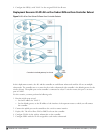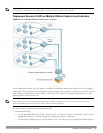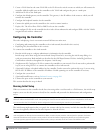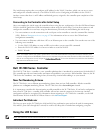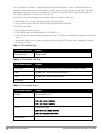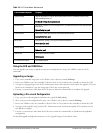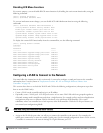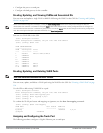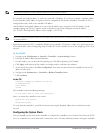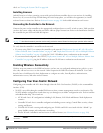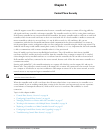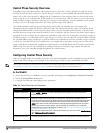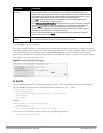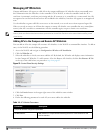
75 |The BasicUser-CentricNetworks DellPowerConnectW-SeriesArubaOS6.2 | User Guide
In the WebUI
1. Navigate to the Configuration > Network > Ports window on the WebUI.
2. In the Port Selection section, click the port that will connect the controller to the network. In this example, click
port 25.
3. For Port Mode, select Trunk.
4. For Native VLAN, select VLAN 5 from the scrolling list, then click the left (<--) arrow.
5. Click Apply.
In the CLI
interface gigabitethernet 1/25
switchport mode trunk
switchport trunk native vlan 5
To confirm the port assignments, use the show vlan command:
(host) (config) #show vlan
VLAN CONFIGURATION
------------------
VLAN Name Ports
---- ---- -----
1 Default Fa1/0-23 Gig1/24
5 VLAN0005 Gig1/25
Configuring the Default Gateway
The following configurations assign a default gateway for the controller.
In the WebUI
1. Navigate to the Configuration > Network > IP > IP Routes window.
2. To add a new static gateway, click the Add button below the static IP address list.
a. In the IP Address field, enter an IP address in dotted-decimal format.
b. In the Cost field, enter a value for the path cost.
c. Click Add.
3. You can define a dynamic gateway using DHCP, PPPOE or a cell uplink interface. In the Dynamic section, click
the DHCP, PPPoE or Cellular checkboxes to select one or more dynamic gateway options. If you select more
than one dynamic gateway type, you must also define a cost for the route to each gateway. The controller will
first attempt to obtain a gateway IP address using the option with the lowest cost. If the controller is unable to
obtain a gateway IP address, it will then attempt to obtain a gateway IP address using the option with the next-
lowest path cost.
4. Click Apply.
In the CLI
ip default-gateway <ipaddr>|{import cell|dhcp|pppoe}|{ipsec <name>} <cost>
Configuring the Loopback IP Address for the Controller
You must configure a loopback address if you are not using a VLAN ID address to connect the controller to the
network (see "Deployment Scenario #3: APs on Multiple Different Subnets from Controllers" on page 68).



